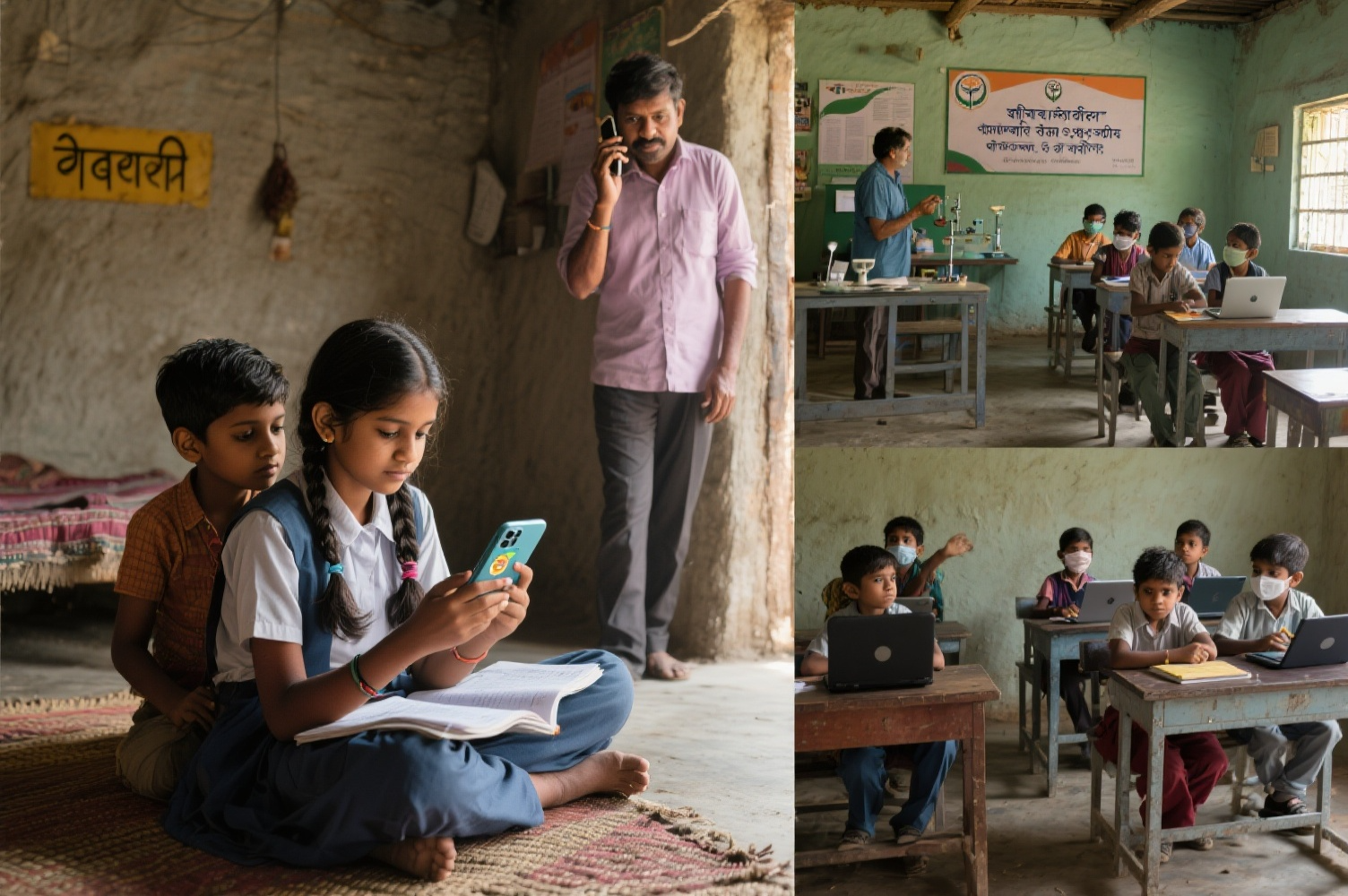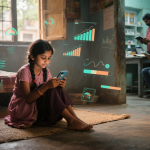- December 7, 2023
- by Educational Initiatives
- Blog
- 0 Comments
This is the first of a three-part series documenting Ei’s attempts to help students use its Personalised Adaptive Learning software, Mindspark, during the COVID-19 pandemic. This article focusses on the process of reaching students at home, while the second article will showcase key insights from Mindspark usage data, and the third will highlight learnings from this process of implementation
____
The 18 months have been unimaginably challenging for India’s children. Kept out of school by COVID-19, they have struggled to learn. School re-openings have been uncertain and short-lived, worsening an existing learning crisis. A study by Azim Premji University in 2021 noted that between grades 2-6, 82% of students in mathematics and 92% of students in language had lost at least one specific ability in this period. The long-term losses from are estimated to be severe – far surpassing learning loss experience during the pandemic itself. The World Bank estimated a loss of $5,813 in lifetime earnings per child in South Asia whose learning has been affected in this time.
To help students learn in this period, Ei made Mindspark, it’s Personalised Adaptive Learning software, available to use at home. Students were given login credentials through which they could use Mindspark on smartphones or other computing devices their families owned. However, EdTech solutions remain a radical departure from schooling-as-usual in many parts of the country. Therefore, facilitating Mindspark usage during the pandemic, especially in remote and rural areas, was challenging. To do so, Ei had to engage with governments, schools and teachers, and students’ families and communities, understanding each stakeholders priorities and constraints.

Government engagement
Government approval was necessary for schools to give Ei student contact details so field teams could reach them at home. Additionally, their support also helped legitimise the endeavour among stakeholders on the ground.
While government education departments were indeed looking for remotely accessible educational interventions, they prioritised solutions that a majority of students could use. Given Mindspark’s dependence on computing devices, some officials were sceptical of its potential. Additionally, state capacity was stretched thin at this time and focussed initially on public health efforts. Permissions, therefore, took time to come and active government engagement with Mindspark remained limited.
Where government officials were previously familiar with Ei and Mindspark, implementation was smoother. For example, Ei had set up Mindspark labs in multiple districts of Rajasthan since 2017, and stakeholders in the state had seen the programme’s benefits over the years. They were, therefore, more amenable and encouraged adoption amongst schools even as formal processes took time.
Working with Schools and Teachers
Schools were crucial intermediaries in the implementation of Mindspark at home. First, they provided contact details of students’ families. Additionally, Ei field-teams also sought teachers’ assistance in contacting students and encouraging Mindspark usage.
However, schools and teachers played a limited role in outreach. While some encouraged students to use Mindspark, they remained the exception, not the rule. This was understandable, given their considerable work at the time. They had to find their own ways to teach the school curriculum remotely. Furthermore, in many states school teachers were co-opted for both pandemic relief work and election duties, placing significant demands on their time
Additionally, field teams observed reservations about such external interventions among teachers. In Nandurbar, Maharashtra, teachers noted that previous projects with external organisations, despite beginning enthusiastically, halted soon after they began. They were therefore hesitant to devote time to initiatives that would not last.
Reaching Students on the Ground
Ei’s primary targets for remote usage were students whose families possessed computing devices (primarily smartphones). Reaching them was challenging and required constant innovation, since there were no established channels of communication or outreach.
First, field teams and Ei’s call centre contacted parents using details shared by schools. They aimed to introduce families to Mindspark and share login credentials. Ei’s call centre reflects this increased activity; the call centre alone made 118,234 calls between April 2020 and March 2021, compared to 15,239 calls between April 2019 and March 2020. Inbound calls to the call centre more than doubled from 1,659 to 3,229 as users sought assistance. This was over and above the direct outreach done by field teams.
Reaching parents, however, was easier said than done. Phone numbers shared by schools were often invalid or unreachable. Just over 40% of calls from the call centre successfully connected. Even amongst those families that were reached, many only had basic mobile phones, not smartphones.

Image 1 Team members orienting students on the Mindspark platform
Even amongst students in families with smartphones, low digital literacy and language barriers hampered outreach. Especially in remote areas, people often spoke regional dialects that team members did not. In such cases, team members would request that neighbours or other family members who did speak a common language be given the phone instead. After introducing families to Mindspark, team members would share login credentials and the website link over SMS. However, people were often unaware of terms like “User ID”, “Password” and “link”. (at least when expressed in English). The login credentials shared were also in English; this required them to change the keyboard language on phones, which parents were not always able to. To solve this, children (who were often more comfortable with technology) were asked for assistance if possible.
Remote orientations like these had limited effect. Therefore, when lockdowns lifted, field teams visited students in their localities. In situations where schoolteachers were visiting villages to distribute learning material, Ei’s field teams accompanied them to simultaneously spread awareness of Mindspark. Positioning Mindspark as an initiative supported by schools helped legitimise the programme in the eyes of students and parents. Ei also partnered NGOs and volunteers on the ground, hoping their human resources and familiarity in local networks would increase uptake. Though not always successful, in many places these partners could reach students faster than Ei’s team members.
Even when families did have smartphones, children were not always able to use them. As parents returned to work, their children lost access to phones. Often, parents were also hesitant to let children use devices, afraid that they may damage them. While only 20-30 minutes of daily Mindspark usage could help students learn effectively, since children also had to use phones for other schoolwork, parents worried that extended screen usage may be harmful. Where elder siblings had smartphones, they were unwilling to let their younger siblings use them, fearing they would access private files and messages.
Because of low access to devices at home, Ei’s field teams periodically set up community labs where students could use Mindspark. Field teams identified locations like community centres, panchayats offices, etc. where children could gather while maintaining social distancing. They then informed parents and students of these labs and convinced them to attend. Then, they would take laptops and tablets to these locations, supervising student usage.

Image 2: Students using Mindspark in a Community Lab in Lucknow.
Such labs were easier to establish in urban areas where student density was greater and distances to travel shorter, than in rural and remote regions where students were spread out across large distances. In the rural district of Nandurbar, for example, community labs could only be set up occasionally. In the city of Lucknow, meanwhile, they were established daily. Between 5,000-6,000 students here used these labs for almost 10 hours each in language and mathematics, far exceeding usage in rural areas.
To incentivise enrolment and encourage usage, Ei rewarded high-performing students. Generally, top performers in each district received tablet computers to help them study. In some cases, students were also given stationery kits. These awards were presented in ceremonies by important local officials and frequently covered by local media. This added to Mindspark’s prestige and generated awareness regarding the programme.
From Crisis to Opportunity
Despite all the challenges faced in this period, Ei’s field teams were able to grow Mindspark’s reach in this period relative to the previous academic year. With expensive in-school labs no longer needed, far more students could be reached. Though reaching them was difficult, over 1,20,000 students were able to learn with Mindspark at home in this period.



